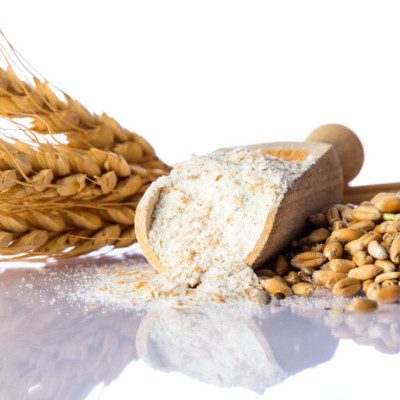Origin
Milling of foodstuffs is an ancient craft, dating back thousands of years to the dawn of civilization. The first food materials to be ground were probably cereal grains. Milling and baking scenes have been found on walls of Egyptian tombs dating back to 2600 BC. By reducing the average particle size of foods, humans were able to enjoy more palatable forms of meals, access different nutritious components, make food preparations easier to chew and create different products from the same source or raw material.1
How does milling work?
Grain milling is essentially a process of separating the grain into its constituents, i.e. germ, bran and endosperm. It serves three main purposes: the breaking and opening of kernels, purification of endosperm and further particle size reduction. Various classes of products can be produced from milling wheat, corn, oats and other grains ranging from fine flour to semolina, grits and flakes.
The milling of wheat starts with cleaning and tempering/conditioning the grain by adding water and/or heat. The tempered grains are placed between two large metal rollers (breakers) to separate the bran, followed by sieving and partitioning into three streams:
- Coarse material: semolina
- Large particles: composed of aleurone with bran still attached to it.
- Very fine material: referred to as farina or middlings, they are the basis for making flour. The middlings, are sent to a purifier and the retained materials are transferred back to another set of breaker rolls. The purifier middlings are sieved via vibration and air is blown over to rid them of bran residues. The middlings are allowed to pass several times through the rollers for more grinding and are sifted to various flour grades. The latter are combined at different ratios to form flours of various specifications.
Application
Choosing adequate systems and conditions depends greatly on the type of wheat and target product among other factors. In hard wheats, for example, the starch and protein components of the endosperm are very tightly bound, thus requiring longer tempering times and more mills and reduction systems compared to soft wheats with soft endosperms. Milling of soft wheats produces fine particles with narrow size distribution. These flours tend to agglomerate and are very difficult to sift.
In wet milling, the flour is mixed with water to form a dough-like mass. Subsequent mechanical kneading and washing with a stream of water leads to the separation of a gluten cake which is retained on the sieve. Starch, on the other hand, is recovered by centrifuging the aqueous filtrates. The gluten cake and starch filtrates are dried separately to generate ‘vital gluten’ and starch powder, respectively.
Particle size reduction serves a number of different objectives:
- Accelerating heat and mass transfer
- Increasing the surface area of materials (relevant for mixing operations and bioprocesses)
- Intensifying flavors and aromas (overall quality of foods)
- Facilitating separation of different parts of a material (germ, bran and endosperm from wheat)
- Obtaining a desirable product texture
- Facilitating mixing and dispersion
- Obtaining pieces and particles of defined shapes
Standard cereal milling operations can yield products with a particle size range of 50–750 μm. Flour particles belong to the range of 75–180 μm, semolina particles with a range of 200–500 μm and other byproducts with a wide particle size distribution, depending on the intensity of the treatment.2
Various techniques can yield flours of wide differences in their particle size and distribution, critical for flour functionality. Milling can also impact the quality and baking performance of cereal flours. Attributes such as damaged starch, ash content (bran inclusion), rate and amount of water absorption of flour, all depend on the type and nature of the cereal milling process.
References
- Walker, C.E., and Eustace, W.D. “Milling and Baking: History” Encyclopedia of Food Grains, 2nd ed., vol. 3, Elsevier Ltd., 2016, pp. 299–305.
- Gruber, W., and Sarkar, A. “Durum Wheat Milling” Durum Wheat Chemistry and Technology, 2nd ed., AACC International, Inc., 2012, pp. 139–159.

